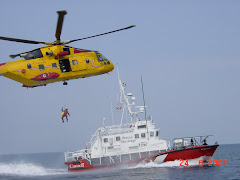After getting to Resolute we marched to the Narwhal hotel where we would be staying for a few night. All the kit was shipped over on palettes by forklift. After getting the hotel brief and sorting out some kit we ate supper and proceeded outside to learn some stuff. Arctic lanterns which can be used as a signal (basically a pylon of snow with a candle in it), are surprisingly bright. Especially in a place where the sun does not shine. We spent two nights in the Narwhal with the days spent outside learning how to build makeshift shelters and basically just spending time outside trying to get used to the environment. The snow up there is extremely dry. It's just too cold. But because of the wind it gets packed very solidly and feels like styrofoam. It can be cut like wood into blocks or whatever you want. It's very strong providing you aren't too rough with it.
On the third day we walked out to Crystal City which is a detachment of CFSSAR to begin Arctic survival. Following the survival pattern which is first aid, shelter, fire, signals, food, water. We began to construct snow walls to put our SAR tents in. What a pain in the ass. It takes well over 100 snow blocks to have enough to shield your tent from the wind. The tent is also extremely cold to sleep in up there. That being said it should only be used as a temporary shelter. If you're going to be up there for more than 24 hours you should think about constructing something more permanent such as a snow cave or igloo. Which brings us to day two. Snow caves. At the start of every morning we go for walks with the inuit to learn. Navigation by stars and snowdrifts depanding on prevailing winds, what type of snow is good to melt and drink, and even how to dodge polar bears charges. The snow cave took all day to dig and since it needs to be quite confined in order to provide some insulation, most of that digging gets done in very awkward positions. The snowcave was the warmest (relatively speaking of course...... nothing is warm up there) or all the shelters, but it was uncomfortably small. Try getting out of a dual layer sleeping bag and bivy bag without waking your buddy in a space just big enough for the both of you and only about a meter high, than having to crawl down a tunnel to pee into a block of snow (called a kovik) and then having to climb back up and into your bag again.
We stayed two nights in the caves. I slept about 12 hours the second night. The instructors told us a storm was coming and to get into our caves and just get some down time. An exercise to see how comfortable we would be if we had to stay an extended period of time in the shelter which is exactly what you would do in a survival situation. It was okay. Then it was on to the construction of igloos. We watched the inuit build an igloo and then immediately build our own. I love the way this course is run! You watch a demo and then immediately turn around and employ it to make sure you've absorbed the info. Best be a quick learner on this course. Anyway the igloos were by far the easiest shelter to make. Less grunt work but way more skill required. I would have like to have had the time to build a couple more just to get it down. Turns out the igloo provides a little bit more room but Matt & I's was cold. I don't think we took the time to properly insulate the inside. Although most of the guys were cold in the igloo so maybe it wouldn't have helped.
The morning after the night in the igloo a storm hit. It was crazy. 70km/h winds dropped the temp to around -50 C. Our morning walk and days activities were cancelled and we were told to just stay inside the igloos. Eventually the exercise ended and we went back to the Narwhal hotel but due to the weather out plane couldn't land so we got stuck up in Resolute for 3 extra days. That was fine since we all needed the downtime prior to dive phase but it would've been better spent at home with our families.




No comments:
Post a Comment